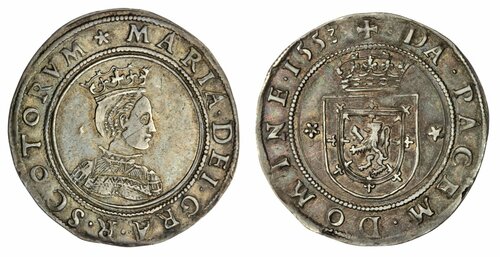
Auction: 21007 - British and World Coins Autumn Auction
Lot: 145
Mary, Queen of Scots, First Period (1542-1567), Four-Shilling 'Portrait' Testoon, 1553, Type I, 'Late Dies' by John Achesoun, MARIA • DEI • GRA • R • SCOTORVM, small Os, crowned bust right, wearing finely incised bodice, stops in legend, rev. + • DA • PACEM • DOMINE • 1553 •, small Os, crowned shield flanked by cinquefoils, 5.04g, 10h, m.m. cinquefoil/cross (Murray [1968], E4 and Pl. XII, 16/19 same dies; Wingate 237 = Murdoch 187 = Lockett V, 313 same dies; Dundee 126-127; GLAHM 38996 same dies; SCBI 35, 1000-1001 and SCBI 58, 284, same dies; St. 166; Lindsay [1845] 179; Murray [SNC, Dec. 1981, pp. 397, no. 18 this coin; Burns I, Fig. 780; Richardson 1; Spink 5481), an astonishing example of this seldom encountered pre-Marital coinage, a faint mark on cheek, otherwise delightfully toned, virtually extremely fine for issue and of the highest rarity thus; Murray recording only 21 specimens extant, and only eight from this die pairing with three institutionalised, believed to be the finest known specimen either in public or private hands
Spink, 17 February 1982
SNC, December 1981, no. 8425 - 'A previously unrecorded specimen. Extremely rare and in choice condition; in our opinion the finest known specimen [most of the surviving twenty-one coins are very worn, partly because they are in such low relief to start with] - £10,000
A great mystery remains about the production site of this enchanting coinage. Burns rather curiously opines that the dies for the series were prepared at the Paris Mint by John Achesoun, and latterly exhibited by him at the French court on 21 October 1553. Interpreting them to have been amongst the first coins to have been struck by new mill press, Burns identifies the series with the new process introduced at the French mint two years earlier. Latter scholarship by Murray has effectively rubbished this hypothesis, although there are circumstantial facts worthy of consideration in this remarkable Queen's life. Following the Treaty of Greenwich, signed on 1 July 1543, a marriage accord was agreed between King Edward VI and Princess Mary, the latter was then sent to the French court for her upbringing.
Described by contemporaries as "vivacious, beautiful, and clever", by most accounts Mary had a promising childhood at French court. Reportedly she would befriend all there, except King Henri II's wife Catherine de Medici. As part of her education, Mary learned to play lute and virginals, and was competent in prose, poetry, horsemanship, falconry and needlework. She would become fluent in French, Italian, Latin, Spanish and Greek, all in addition to speaking her native Scots.
The present coin, the earliest to depict the Royal Scottish female countenance, depicts Mary with her characteristic small, oval-shaped head and long, graceful neck. Paintings depict her bright auburn hair and hazel-brown eyes. Notably also they depict her heavy lowered eyelids and finely arched brows, both of which are reflected, almost 'monocle' like in the present specimen. Like her cousin Queen Elizabeth, she would catch smallpox, but it appears not to have cause her debilitating or unsightly features.
Mary was remarkably tall for 16th-century standards, reportedly attaining an adult height of 5ft. 11in. whilst her future husband Francis, was said to stutter and be unusually short. On 4 April 1558, Mary signed a secret agreement bequeathing Scotland and her claim to England to the French crown if she died without issue. Twenty days later, she married the Dauphin at Notre Dame de Paris, and he became king consort of Scotland. She would not however return to Scottish shores until 19 August 1561, angered over the terms of the Treaty of Edinburgh in which France had agreed to accept Queen Elizabeth as sovereign of England.
The Lockett example, formerly in the Wingate, Addington, Murdoch and Bearman collections has long been regarded as the finest known specimen. Indeed Douglas Liddell's observations of it in 1957 are suitably summarised by his penned statement 'magnificent coin' in the Spink Library copy. However that example has overt double striking in the RV of SCOTORVM and the RIA of MARIA, simply not reflected on the present coin. Consequently and in view of the sheer rarity of examples exhibiting a clean strike (note the sole British Museum specimen acquired in 1899 [BM GHB S98] is exceptionally creased), not only does this make the present coin a serious challenger, but perhaps even renders it a finer all-round example in the eyes of the most discerning connoisseurs. For further information about the origins of the dies, refer to the Proceedings of the Society of Antiquaries of Scotland, 13 May 1872 by Augustus Franks.
The Canadian Antiquary writing in the same year, provides an interesting take on the long-held perception of this magnificent issue:
"A beautiful Testoon with her portrait bearing the date 1553 is the first of her silver coins, it has the arms as usual with the legend DA PACEM DOMINE - 'Give Peace, O Lord'. This is the finest piece of her reign being equal in workmanship to any coin issued at that time in Europe. One was sold in 1838 for $155 and poor copies sell as high as $50. This has excited the cupidity of an individual named Jones living at Dunfermline who endeavoured to supply the deficiency in the market by specimens of his own manufacture, many novices were deceived, and not a few experienced collectors were taken in by his forgeries of this, and other Scotch coins."
Subject to 20% VAT on Buyer’s Premium. For more information please view Terms and Conditions for Buyers.
Sold for
£50,000
Starting price
£12000




